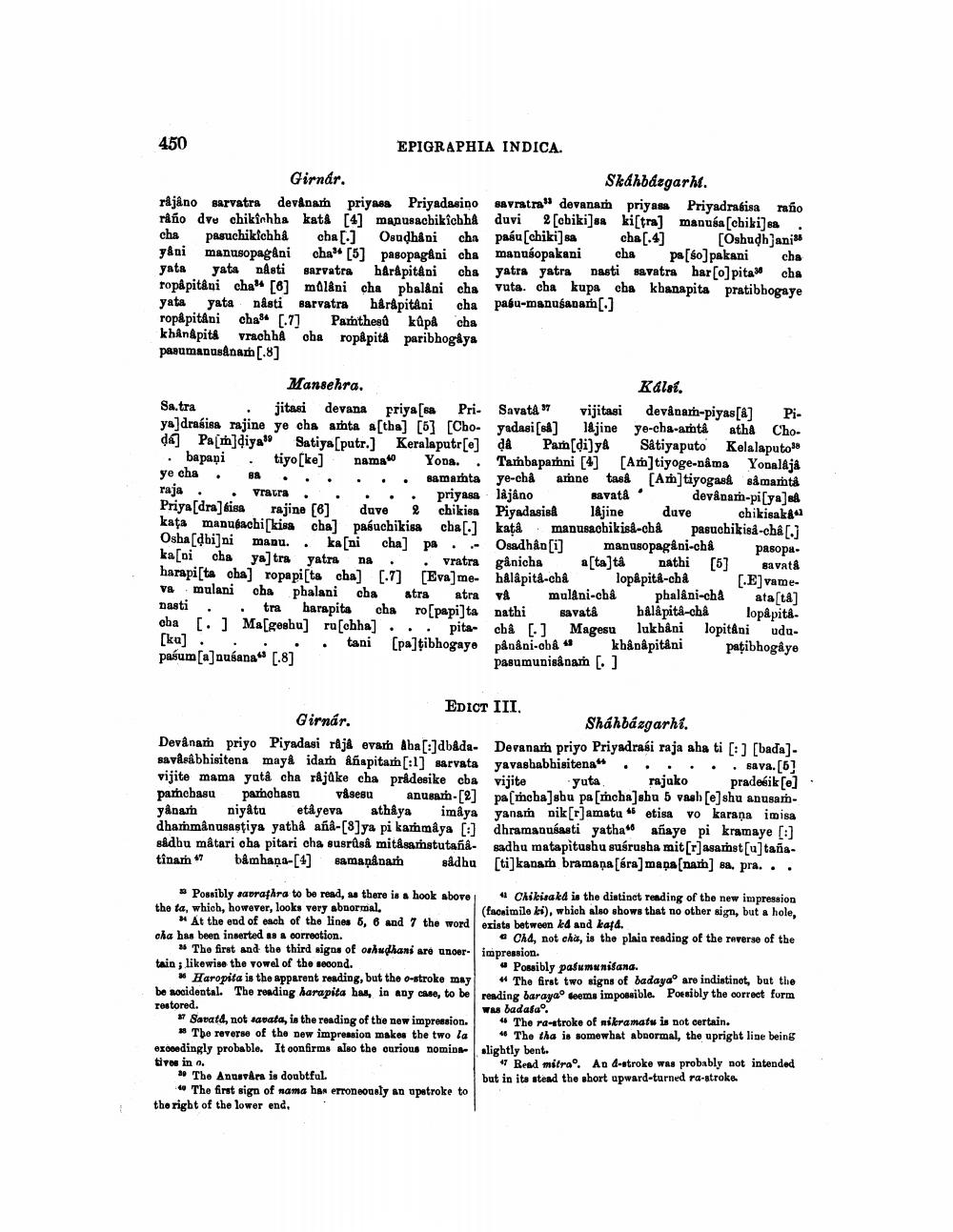________________
450
EPIGRAPHIA INDICA.
Girnár.
rajano sarvatra devânam priyasa Priyadasino raño dve chikichha kata [4] manusachikichha cha pasuchikichhâ cha [.] Osuḍhâni cha yani manusopagani cha [5] pasopagâni cha yata yata nasti sarvatra hârâpitâni cha ropâpitâni cha [6] môlâni cha phalani cha yata yata nâsti sarvatra hârâpitâni cha ropâpitâni cha [7] Pamthest kúpân cha khanapita vrachha cha ropâpitâ paribhogaya pasumanusanam [.8]
88
Mansehra.
Sa.tra jitasi devana priya [sa Priya]drasisa rajine ye cha amta a [tha] [5] [Choda] Pa[m]diya Satiya [putr.] Keralaputr[e] bapani tiyo [ke] nama 40 Yona. ye cha
vratra
Savata 37 vijitasi devânam-piyas[a] Piyadasi [s] lajine ye-cha-amtâ atha Cho. ḍa Pandiya Sâtiyaputo Kelalaputo Tambaparhni [4] [Am]tiyoge-nâma Yonalájá samarta ye-châ amne tasa [Am]tiyogas sâmamtâ raja priyasa lajâno Bavatâ devânam-pi[ya]s Priya[dra] rajine [6] duve 2 chikisa Piyadasisa lajine duve chikisaka kata manusachi kisa cha] pasuchikisa cha [.] kata manusachikisa-châ pasushiki-cha[] Osha[dhi]ni manu.. ka[ni cha] Osadhân [i] manusopagani-châ ka[ni cha ya] tra yatra vratra gânicha a[ta]tâ nathi [5] savatâ harapi[ta cha] ropapi[ta cha] [7] [Eva] me- hâlâpita-châ lopâpita-châ [E]vameva mulani cha phalani cha atra atra vå mulani-châ phalini-cha ata[tâ] tra harapita cha ro[papi]ta nathi savatâ halâpita-châ lopâpitâ. cha [.] Ma[geshu] ru [chha]... pita- châ [-] Magesu lukhâni lopitâni udu[ku] tani [pa]tibhogaye pânâni-châ khản pitâni patibhogâye pasumunisânam [.]
pa
pasopa.
na
nasti
pasum [a]nusana [.8]
EDICT III.
Girnár.
Devanam priyo Piyadasi raja evam aha[:]dbadasavasâbhisitena maya idam âñapitam [:1] sarvata vijite mama yutâ cha râjake cha prådesike cba parichasu parichasu våsesu anusam-[2] yanam niyâtu etâyeva athaya imâya dhammânusastiya yatha añâ-[3]ya pi kammâya [:] sådhu mâtari cha pitari cha susrâsâ mitâsamstutañatinam "7 bamhana-[4] samananaṁ sadhu
Possibly savrathra to be read, as there is a hook above the ta, which, however, looks very abnormal.
Skákbdagar.
savratra" devanam priyasa Priyadrasisa raño duvi 2 [chiki]sa ki[tra] manusa [chiki] sa pasu [chiki] sa cha [.4] [Oshudhani manusopakani cha pa[4]pakani cha yatra yatra nasti savatra har [o]pita cha vuta. cha kupa cha khanapita pratibhogaye pasu-manusanam [.]
At the end of each of the lines 5, 6 and 7 the word cha has been inserted as a correction.
25 The first and the third signs of oshudhani are unoertain; likewise the vowel of the second.
Haropita is the apparent reading, but the o-stroke may be accidental. The reading harapita has, in any case, to be
restored.
Savatá, not savata, is the reading of the new impression. The reverse of the new impression makes the two la exceedingly probable. It confirms also the curious nomina tives in o.
30 The Anusvára is doubtful.
40 The first sign of nama has erroneously an upstroke to the right of the lower end,
Kálsi.
Shahbdagarht.
Devanam priyo Priyadrasi raja aha ti [:] [bada]yavashabbisitena" sava.[5] vijite yuta rajuko pradesik [e] pa(mcha] shu pa [mcha]shu 5 vash [e]shu anusamyanam nik[r]amatu etisa vo karana imisa dhramanusasti yatha añaye pi kramaye [:] sadhu matapitushu suśrusha mit[r]asamst [u]taña[ti]kanamh bramana [éra] mapa [nam] sa, pra. . .
Chikisaka is the distinct reading of the new impression (facsimile ki), which also shows that no other sign, but a hole, exists between kd and kafd.
Chd, not cha, is the plain reading of the reverse of the impression. "Possibly pasumunitana.
The first two signs of badaya are indistinot, but the reading baraya seems impossible. Possibly the correct form was badala.
The ra-stroke of nikramatu is not certain.
The tha is somewhat abnormal, the upright line being slightly bent.
47 Read mitra. An 4-stroke was probably not intended but in its stead the short upward-turned ra-stroke.




